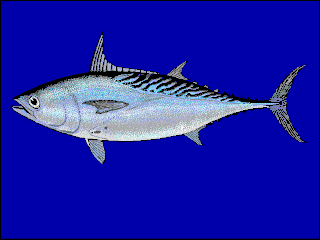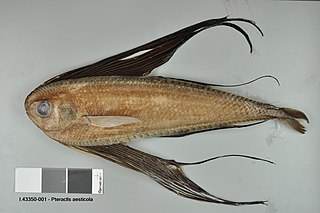
The Chiasmodontidae, snaketooth fishes or swallowers, are a family of deep-sea predatory ray-finned fishes, part of the order Scombriformes, that are found in all oceans.

Tetrapturus is a genus of marlins commonly called spearfish, found in tropical and subtropical oceans throughout the world. Some are popular sport fish in big-game fishing.
The Papuan seerfish also called the Papuan Spanish mackerel, is a species of fish in the family Scombridae. It is endemic to the Gulf of Papua off the mouth of the Fly River. It is the smallest species in the genus Scomberomorus. Sexual maturity is attained at much less than 30 cm fork length.

Benthodesmus tenuis, the slender frostfish or ribbon scabbardfish, is a species of cutlassfish in the family Trichiuridae.

Euthynnus is a genus of ray-finned bony fish in the family Scombridae, or mackerel family, and in the tribe Thunnini, more commonly known as the tunas.

Rastrelliger is a mackerel genus in the family Scombridae. The three species of Rastrelliger together with the four species of Scomber comprise the tribe Scombrini, known as the "true mackerels".
The black snake mackerel is a species of snake mackerel found worldwide in both tropical and temperate waters where they are found at depths of from 914 to 1,646 metres making diel vertical migrations from mesopelagic depths to the surface at night. It can reach a length of 25 centimetres (9.8 in) SL though most do not exceed 15 centimetres (5.9 in) SL. It is important to local peoples as a food fish. This species is currently the only known member of its genus, Nealotus. That genus is therefore said to be monotypic.

The blacksail snake mackerel, known also as the black snoek, is a species of snake mackerel found in the Indo-Pacific from shallow water to a depth of at least 400 m (1,300 ft) where they appear to prefer slopes on seamounts and ridges. They are known for making diel vertical migrations to near-surface waters at night, feeding on fish, squid and crustaceans. This species reaches a total length of 2 m (6.6 ft) though most are around 1 m (3.3 ft). This species is of minor importance to local commercial fisheries. It is at the only member of the genus Thyrsitoides, making the genus monotypic.

Citharus linguatula, the spotted flounder or Atlantic spotted flounder, is a species of fish in the Citharidae, a family of flounders. It is native to the eastern Atlantic Ocean and the Mediterranean Sea, where it is found to a depth of 300 m (980 ft). This species grows to a total length of 30 cm (12 in). It is of minor importance to local commercial fisheries. This species is the only known member of its monotypic genus.

Hippoglossina is a genus of large-tooth flounders native to the coastal Pacific waters of the Americas. A single species, H. oblonga is found along the Atlantic coast of United States and Canada, but it is frequently placed in Paralichthys instead of Hippoglossina.
Vanstraelenia chirophthalma, the African solenette, is a species of sole native to the Atlantic coast of Africa where it is found from Guinea-Bissau south to Angola. Occurring at depths of from 8 to 100 metres, this species is of importance to local commercial fisheries. This species grows to a length of 28 centimetres (11 in) TL. This species is the only known member of its genus.

The sand sole is a fish species in the family Soleidae. It is a marine, subtropical, demersal fish up to 40 centimetres (16 in) long.

Pteraclis is a genus of ray-finned fish in the family Bramidae, the pomfrets. They are known commonly as fanfishes. The three species are distributed throughout the oceans of the world.

Taractichthys is a genus of marine ray-finned fishes from the family Bramidae, the pomfrets.

Chiasmodon is a genus of snaketooth fishes.

Dysalotus is a genus of ray-finned fish in the family Chiasmodontidae found in the Atlantic, Indian and Pacific Ocean.

Pseudoscopelus is a genus of snaketooth fishes.
Rexichthys johnpaxtoni, the Paxton's escolar, is a species of snake mackerel found in the western Pacific Ocean from around Australia and New Caledonia where it is found at depths of from 270 to 470 metres. This species grows to a length of 22 centimetres (8.7 in) SL. This species is the only known member of its genus, the specific name honours John R. Paxton, a curator of the collection of fishes of the Australian Museum in Sydney.

Lepidopus is a genus of cutlassfishes.

Dysalotus alcocki is a species of deep sea fish, a swallower, from the family Chiasmodontidae which is found in the tropical and temperate oceans around the world. The adults fed mainly on fish. The juveniles and larvae are most frequently recorded from shallower waters while adults are mostly caught from depths of over 1,000 metres (3,300 ft). The generic name is derived from the Greek dysalotos which means "difficult to catch" and the specific name honours the English zoologist Alfred William Alcock (1859-1933).














